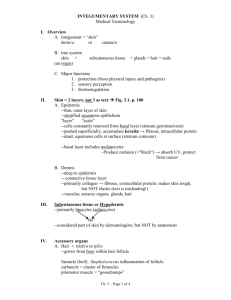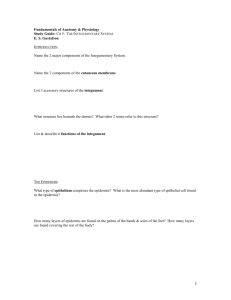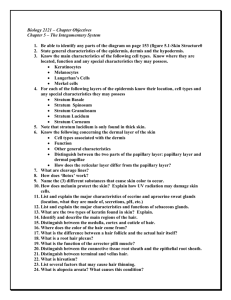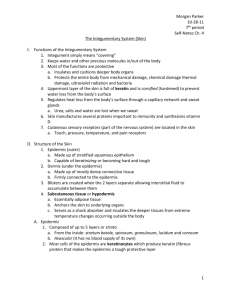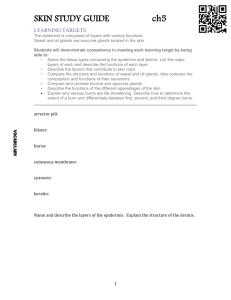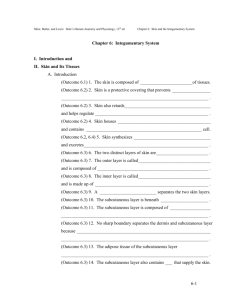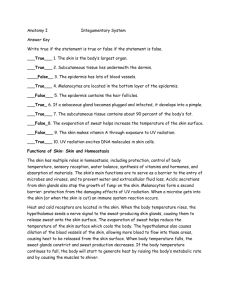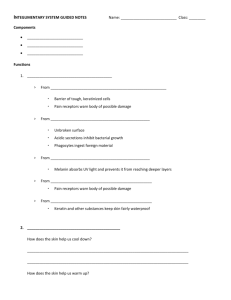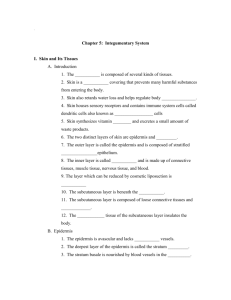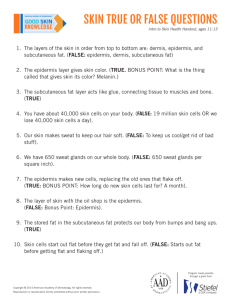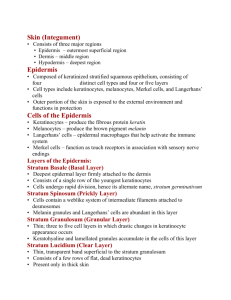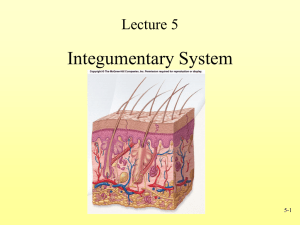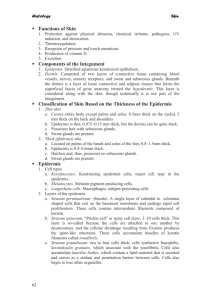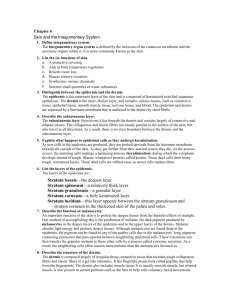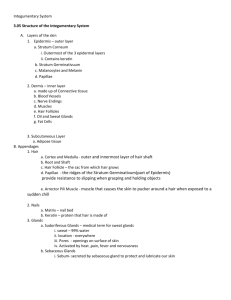Module 8 Exam Review 1. The arrector pili muscle is attached to a
advertisement
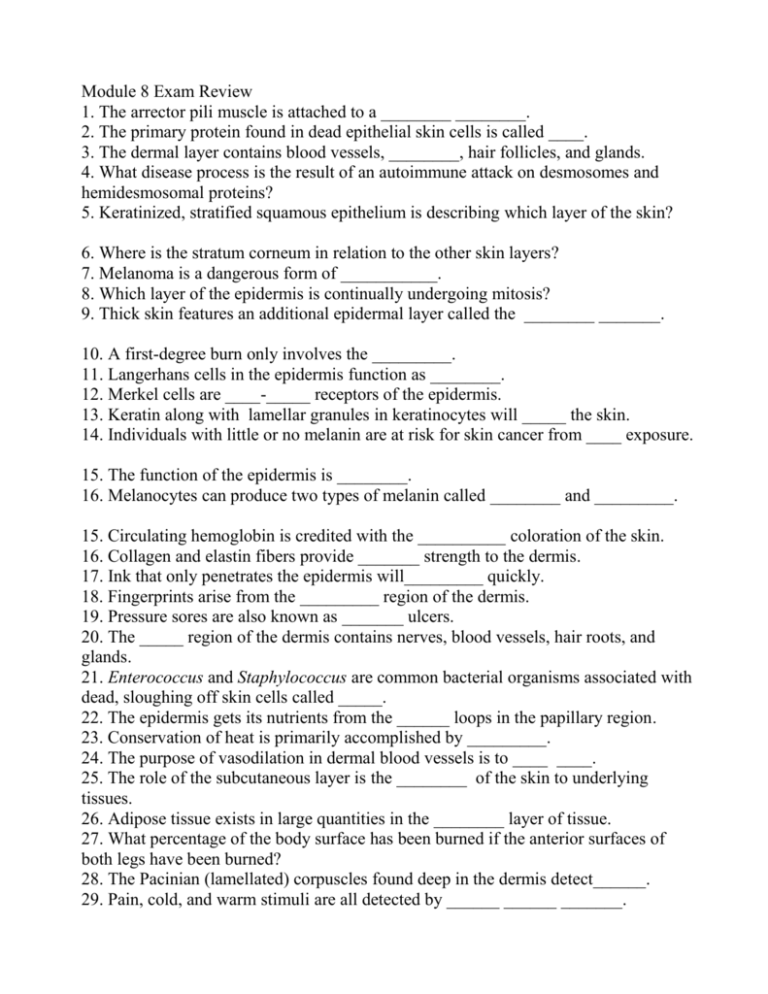
Module 8 Exam Review 1. The arrector pili muscle is attached to a ________ ________. 2. The primary protein found in dead epithelial skin cells is called ____. 3. The dermal layer contains blood vessels, ________, hair follicles, and glands. 4. What disease process is the result of an autoimmune attack on desmosomes and hemidesmosomal proteins? 5. Keratinized, stratified squamous epithelium is describing which layer of the skin? 6. Where is the stratum corneum in relation to the other skin layers? 7. Melanoma is a dangerous form of ___________. 8. Which layer of the epidermis is continually undergoing mitosis? 9. Thick skin features an additional epidermal layer called the ________ _______. 10. A first-degree burn only involves the _________. 11. Langerhans cells in the epidermis function as ________. 12. Merkel cells are ____-_____ receptors of the epidermis. 13. Keratin along with lamellar granules in keratinocytes will _____ the skin. 14. Individuals with little or no melanin are at risk for skin cancer from ____ exposure. 15. The function of the epidermis is ________. 16. Melanocytes can produce two types of melanin called ________ and _________. 15. Circulating hemoglobin is credited with the __________ coloration of the skin. 16. Collagen and elastin fibers provide _______ strength to the dermis. 17. Ink that only penetrates the epidermis will_________ quickly. 18. Fingerprints arise from the _________ region of the dermis. 19. Pressure sores are also known as _______ ulcers. 20. The _____ region of the dermis contains nerves, blood vessels, hair roots, and glands. 21. Enterococcus and Staphylococcus are common bacterial organisms associated with dead, sloughing off skin cells called _____. 22. The epidermis gets its nutrients from the ______ loops in the papillary region. 23. Conservation of heat is primarily accomplished by _________. 24. The purpose of vasodilation in dermal blood vessels is to ____ ____. 25. The role of the subcutaneous layer is the ________ of the skin to underlying tissues. 26. Adipose tissue exists in large quantities in the ________ layer of tissue. 27. What percentage of the body surface has been burned if the anterior surfaces of both legs have been burned? 28. The Pacinian (lamellated) corpuscles found deep in the dermis detect______. 29. Pain, cold, and warm stimuli are all detected by ______ ______ _______. 30. Odors produces by apocrine sweat glands are called _____________. . 31. Sebaceous glands are a compound, ________ glands connected to a hair follicle. 32. Eccrine and apocrine glands are both ______________ glands. 33. _____ sweat glands are coiled tubular glands found on all skin surfaces. 34. Xeroderma pigmentosum is a skin disorder that resulted from a failure of ____ ____. 35. Rapidly dividing cells are found in the ______ and _____ matrices. 36. The medulla, cortex, cuticle are all part of the _____ ______ and the _____ _____. 37. The anagen stage of hair growth is characterized by the ______of the hair shaft? 38. The telegen stage of hair growth is taking place when the hair shaft ____ _____. 39. The fetal skin develops from the embryonic layer of tissue called the _____ (4th week). 40. Thermoregulation changes with age because of the redistribution of the ____ layer.. 41. The stratum basale is the skin layer responsible for filling ______wounds. 42. Deep wounds extend into the _____ and _____. 43. _______ are activated to form scar tissue. 44. The papillary region of the dermis houses the _____ corpuscles and _____ ____ endings. 45. The skin turning pink or red is an indicator of vaso-_________. 46. The palms, fingertips, and soles of the feet are considered to be _____ skin. 47. A second-degree burn involves the epidermis and __________. 48. A burn that involves loss of function, both layers of the skin and even the subcutaneous layer is a _____-_____ _____. 49. Adipocytes are found in large quantities in the _______layer. 50. Thermoregulatory is managed by ________, _______, and _________. Module 8 Exam Review 1. hair follicle 2. keratin 3. nerves 4. pemphigus 5. epidermis 6. superficial 7. skin cancer 8. stratum basale 9. corneum 10. epidermis 11. phagocytic cells (macrophages) 12. light touch 13. waterproof 14. UV 15. protection 16. pheomelanin, eumelanin 15.. pinkish 16. tensile 17. fade 18. papillary 19. decubitus 20. reticular 21. squamous 22. capillary 23.vasoconstriction 24. dissipate 25. attachment 26. subcutaneous 27. 18% 28. vibrations 29. free nerve endings 30. pheromones . 31. acinar 32. sudoriferous 33. Eccrine 34. DNA repair 35. hair, nail 36. hair root, hair shaft 37. elongation 38. falls out 39. ectoderm 40. subcutaneous 41. superficial 42.epidermis, dermis 43. fibroblasts 44. Meissner, free nerve 45. dilation 46. thick 47.dermis 48. third-degree burn 49. subcutaneous 50. vasoconstriction, vasodilation, sweating
